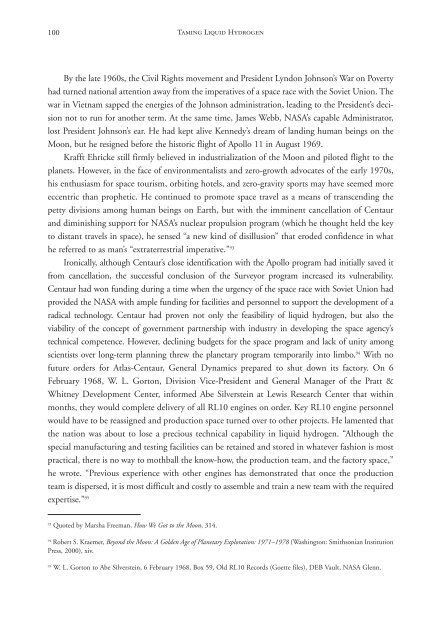Taming Liquid Hydrogen - NASA's History Office
Taming Liquid Hydrogen - NASA's History Office
Taming Liquid Hydrogen - NASA's History Office
Create successful ePaper yourself
Turn your PDF publications into a flip-book with our unique Google optimized e-Paper software.
100<br />
<strong>Taming</strong> <strong>Liquid</strong> <strong>Hydrogen</strong><br />
By the late 1960s, the Civil Rights movement and President Lyndon Johnson’s War on Poverty<br />
had turned national attention away from the imperatives of a space race with the Soviet Union. The<br />
war in Vietnam sapped the energies of the Johnson administration, leading to the President’s decision<br />
not to run for another term. At the same time, James Webb, NASA’s capable Administrator,<br />
lost President Johnson’s ear. He had kept alive Kennedy’s dream of landing human beings on the<br />
Moon, but he resigned before the historic flight of Apollo 11 in August 1969.<br />
Krafft Ehricke still firmly believed in industrialization of the Moon and piloted flight to the<br />
planets. However, in the face of environmentalists and zero-growth advocates of the early 1970s,<br />
his enthusiasm for space tourism, orbiting hotels, and zero-gravity sports may have seemed more<br />
eccentric than prophetic. He continued to promote space travel as a means of transcending the<br />
petty divisions among human beings on Earth, but with the imminent cancellation of Centaur<br />
and diminishing support for NASA’s nuclear propulsion program (which he thought held the key<br />
to distant travels in space), he sensed “a new kind of disillusion” that eroded confidence in what<br />
he referred to as man’s “extraterrestrial imperative.” 93<br />
Ironically, although Centaur’s close identification with the Apollo program had initially saved it<br />
from cancellation, the successful conclusion of the Surveyor program increased its vulnerability.<br />
Centaur had won funding during a time when the urgency of the space race with Soviet Union had<br />
provided the NASA with ample funding for facilities and personnel to support the development of a<br />
radical technology. Centaur had proven not only the feasibility of liquid hydrogen, but also the<br />
viability of the concept of government partnership with industry in developing the space agency’s<br />
technical competence. However, declining budgets for the space program and lack of unity among<br />
scientists over long-term planning threw the planetary program temporarily into limbo. 94 With no<br />
future orders for Atlas-Centaur, General Dynamics prepared to shut down its factory. On 6<br />
February 1968, W. L. Gorton, Division Vice-President and General Manager of the Pratt &<br />
Whitney Development Center, informed Abe Silverstein at Lewis Research Center that within<br />
months, they would complete delivery of all RL10 engines on order. Key RL10 engine personnel<br />
would have to be reassigned and production space turned over to other projects. He lamented that<br />
the nation was about to lose a precious technical capability in liquid hydrogen. “Although the<br />
special manufacturing and testing facilities can be retained and stored in whatever fashion is most<br />
practical, there is no way to mothball the know-how, the production team, and the factory space,”<br />
he wrote. “Previous experience with other engines has demonstrated that once the production<br />
team is dispersed, it is most difficult and costly to assemble and train a new team with the required<br />
expertise.” 95<br />
93 Quoted by Marsha Freeman, How We Got to the Moon, 314.<br />
94 Robert S. Kraemer, Beyond the Moon: A Golden Age of Planetary Exploration: 1971–1978 (Washington: Smithsonian Institution<br />
Press, 2000), xiv.<br />
95 W. L. Gorton to Abe Silverstein, 6 February 1968, Box 59, Old RL10 Records (Goette files), DEB Vault, NASA Glenn.

















